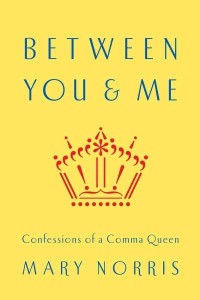Book Review: Between You & Me: Confessions of a Comma Queen
5/7/15 – Review: Between You & Me: Confessions of a Comma Queen
 Some of my best friends are copy editors. No, really. After decades working as a journalist, and now as a novelist, I know how important copy editors can be, how often they save writers from embarrassing errors, and how underappreciated (and underpaid) they are. I’m also aware of the stereotype that suggests copy editors are obsessed, persnickety, humorless, and mean. Like most stereotypes, there’s some truth to it…but not that much.
Some of my best friends are copy editors. No, really. After decades working as a journalist, and now as a novelist, I know how important copy editors can be, how often they save writers from embarrassing errors, and how underappreciated (and underpaid) they are. I’m also aware of the stereotype that suggests copy editors are obsessed, persnickety, humorless, and mean. Like most stereotypes, there’s some truth to it…but not that much.
Enter Mary Norris, the long time page OK’er at The New Yorker, and her new memoir, Between You & Me: Confessions of a Comma Queen. The book is actually a modified memoir—one part life story, one part inside look at the magazine, and two parts lessons on the rules of grammar and why they make sense (but sometimes don’t). Since publication last month, the book has received rave reviews, perhaps because a lot of copy editors, present and past, were selected by their publications to review it.
Whatever else you think after reading Between You & Me, you won’t pin the stereotype label on Norris. She’s funny, friendly, able to keep grammar and writing in perspective, and willing to see different sides of most arguments. She’s even willing to bend the rules in the relatively rare instances when her bosses let her.
The culture at The New Yorker is famous and with good reason. And Norris’s work is worth the read if only for its inside poop on how the place operates. Its layers of editing and fact-checking and proofing—and then doing it all again and again—are legendary. Obsessive? You bet. But you can’t help but wish a lot of other organizations would come closer to the model, both in print on their error-ridden web sites.
That’s not to say that others need to emulate some of The New Yorker’s idiosyncrasies that seem to exist only for the sake of being idiosyncratic. What other publication would put a hyphen in blue-stained glass or insist on the double ‘l’ in “frequent travellers,” when airlines and dictionaries don’t.
Norris is not shy about making fun of some of these practices, but she’s no easy mark for those who want to disregard grammar in the guise of modernizing the English language. Just because everyone else does it is no excuse—not even if everyone includes President Obama, who’s been known to thank people who “graciously invited Michele and I” to one event or another. She attributes the frequent use of “I” where “me” is correct to a misguided effort to sound refined, and though it’s increasingly common, it’s just plain wrong, she insists.
 Norris is equally dismissive of any attempt to trash “whom” as an outdated inconvenience. “‘Whom’ may indeed be on the way out, but so is Venice, and we still like to go there,” she quips.
Norris is equally dismissive of any attempt to trash “whom” as an outdated inconvenience. “‘Whom’ may indeed be on the way out, but so is Venice, and we still like to go there,” she quips.
Norris uses one of her longer chapters to focus on one of today’s most controversial debates among writers, editors, and grammarians: the use of a plural pronoun (they, their, them) when a singular is called for—writing, for example, “everyone wants to do their best,” instead of “everyone wants to do his or her best.” She charts the long history of efforts to find a new, gender-neutral third person-singular pronoun that would serve the purpose, (ne-nis-nim, ip-ips, ha-hez-hem, ta, shem-herm; ho-hos-hom, ze-zon), all of which proved unacceptable. Norris makes it clear she wishes feminists hadn’t messed with the old standard of using “he,” which is still the best alternative in her mind, but then admits she admires male writers “who are secure enough in their masculinity to use the feminine third-person singular.”
Norris has a hilarious section on why the serial comma is essential, noting the problems created when you leave it out of sentences such as “This book is dedicated to my parents, Ayn Rand and God.” And you don’t want to miss the debate over whether to put a hyphen in bad-hair day. Near the conclusion of that section, Norris offers a bit of wisdom that might apply to grammar in general, “I was learning…that a hyphen is not a moral issue.”
Many of the grammar lessons in the book have long been available in Norris’s podcasts at The New Yorker website, and a good chunk of the opening was published in the magazine. In some of the fresher sections of the memoir, Norris describes her personal effort to figure out who put the hyphen in Moby-Dick (a copy editor, not the author). And her loving ode to what she regards as the perfect pencil (the soft graphite Palomino Blackwing 602) and how it is made (based on a visit to the factory) is well worth the price of admission.
Between You & Me: Confessions of a Comma Queen, by Mary Norris, 228 pp. W. W. Norton & Company.
Mark Willen
Mark Willen’s novels, Hawke’s Point, Hawke’s Return, and Hawke’s Discovery, were released by Pen-L Publishing. His short stories have appeared in Corner Club Press, The Rusty Nail. and The Boiler Review. Mark is currently working on his second novel, a thriller set in a fictional town in central Maryland. Mark also writes a blog on practical, everyday ethics, Talking Ethics.com.
- Web |
- More Posts(48)